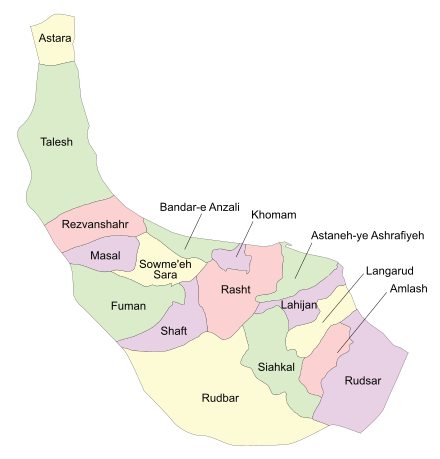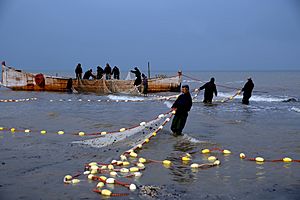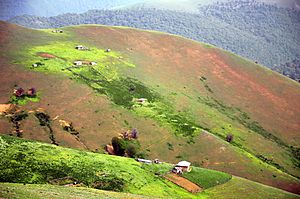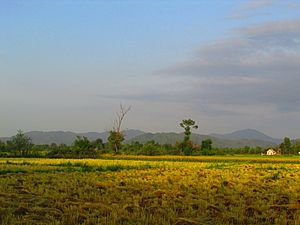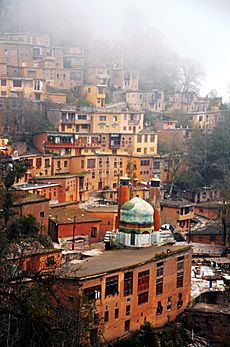Gilan province facts for kids
Quick facts for kids
Gilan province
استان گیلان
|
|
|---|---|
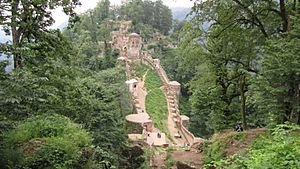
Rudkhan Castle
|
|
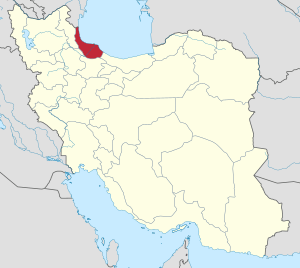
Location of Gilan province in Iran
|
|
| Country | Iran |
| Region | Region 3 |
| Capital | Rasht |
| Counties | 17 |
| Area | |
| • Total | 14,042 km2 (5,422 sq mi) |
| Population
(2016)
|
|
| • Total | 2,530,696 |
| • Density | 180.223/km2 (466.776/sq mi) |
| Time zone | UTC+03:30 (IRST) |
| Area code(s) | 013 |
| ISO 3166 code | IR-01 |
| Main language(s) | Gilaki Talyshi |
| HDI (2017) | 0.805 very high · 11th |
| Others(s) | Persian Azeri |
Gilan province (Persian: استان گیلان, Ostān-e Gīlan) is one of Iran's 31 provinces. It is located along the Caspian Sea in northern Iran. Gilan is part of Iran's Region 3. It shares borders with Mazandaran to the east and Ardabil to the west. To its north, it borders Azerbaijan.
The city of Rasht is the capital of Gilan province. Other important cities include Astaneh-ye Ashrafiyeh, Astara, Fuman, Lahijan, and Bandar-e Anzali. Bandar-e Anzali is the main port city in the province. In 2016, Gilan had a population of about 2.5 million people.
Contents
History of Gilan Province
Gilan has a long and interesting history, with evidence of human life dating back thousands of years.
Early Human Presence
Early humans lived in Gilan during the Lower Paleolithic period. Darband Cave is the oldest known human settlement in the province. It shows that people lived in caves here a very long time ago. Stone tools and animal fossils found there tell us about their lives. Another site, Yarshalman, was likely used by Neanderthals about 40,000 to 70,000 years ago.
Ancient Times
Around the second or first century BCE, a group called the Gelae (or Gilites) settled in the region. They came from the Dagestan area. Studies of DNA and language suggest that the people of Gilan have some roots in the Caucasus region. Their language shares features with languages spoken there.
Medieval Period
Gilan was the home of important dynasties like the Ziyarid dynasty and Buyid dynasty in the 10th century. People from Gilan were also important during the Sassanid dynasty (up to the 7th century). Their power even reached Mesopotamia.
Muslim armies tried to conquer Gilan in 637 AD at the Battle of Jalula. However, the people of Gilan and Deylam (a nearby region) successfully defended their land. They were never fully conquered by the Muslim Arabs. In fact, the Deylamites later conquered Baghdad in 945 AD.
In the 9th and 10th centuries, many people in Gilan gradually adopted Zaydi Shiʿism. There were also raids by Varangian (Norsemen) Vikings on the Caspian Sea coast. Deylamite warriors were known for being strong fighters against these Vikings.
The Buyids were the most successful of the Deylamite ruling families in Iran. However, Turkish invasions in the 10th and 11th centuries ended the Deylamite states. After that, Gilan was ruled by local leaders who paid tribute to larger empires but mostly governed themselves. In 1307, the Ilkhan Öljeitü briefly conquered the region.
Before silk production became popular, Gilan was not a rich province. There were few trade routes. But when silk worms were introduced in the late Middle Ages, Gilan became much wealthier.
Modern History
The Safavid emperor, Shah Abbas I, took direct control of Gilan in the 16th century. From then on, the Persian Shah appointed Gilan's rulers. Many Georgians, Circassians, and Armenians settled in Gilan during the Safavid era. Their descendants still live there today.
In the early 18th century, the Russian Empire under Peter the Great captured Gilan. The city of Rasht was taken in 1722-1723. Russian forces stayed in Gilan for about ten years.
Later, the Qajar dynasty ruled Iran. They lost wars to Russia, which gave Russia a lot of influence in the Caspian region. Russian schools were common in Gilan, and Russian culture had a big impact. This influence lasted until 1946 and played a role in the Persian Constitutional Revolution.
Gilan became very wealthy from silk production starting in the 15th century. It was a major exporter of silk in Asia. The silk trade was a monopoly of the Shah, bringing a lot of money to the empire.
In the mid-19th century, a disease affected silk worms, which hurt Gilan's economy. People started growing rice and tea instead.
After World War I, Gilan was ruled independently for a while. Mirza Kuchik Khan led a movement called the Jangal movement of Gilan. His group helped remove the Qajar ruler Mohammad Ali Shah.
In 1920, British forces entered Bandar-e Anzali. The Jangalis allied with the Bolsheviks (Russians) against the British. This led to the creation of the Persian Socialist Soviet Republic in Gilan, which lasted from June 1920 to September 1921. The Soviets later withdrew their support, and Gilan returned to central government control in September 1921.
Administrative Divisions
Gilan province is divided into several areas called counties. Each county has its own cities and towns. The table below shows how the population of these counties has changed over time.
| Administrative Divisions | 2006 | 2011 | 2016 |
|---|---|---|---|
| Amlash County | 46,108 | 44,261 | 43,225 |
| Astaneh-ye Ashrafiyeh County | 107,801 | 105,526 | 108,130 |
| Astara County | 79,416 | 86,757 | 91,257 |
| Bandar-e Anzali County | 130,851 | 138,004 | 139,016 |
| Fuman County | 96,788 | 93,737 | 92,310 |
| Khomam County1 | — | — | — |
| Lahijan County | 161,491 | 168,829 | 167,544 |
| Langarud County | 133,133 | 137,272 | 140,686 |
| Masal County | 47,648 | 52,496 | 52,649 |
| Rasht County | 847,680 | 918,445 | 956,971 |
| Rezvanshahr County | 64,193 | 66,909 | 69,865 |
| Rudbar County | 101,884 | 100,943 | 94,720 |
| Rudsar County | 144,576 | 144,366 | 147,399 |
| Shaft County | 63,375 | 58,543 | 54,226 |
| Siahkal County | 46,991 | 47,096 | 46,975 |
| Sowme'eh Sara County | 129,629 | 127,757 | 125,074 |
| Talesh County | 179,499 | 189,933 | 200,649 |
| Total | 2,381,063 | 2,480,874 | 2,530,696 |
| 1Separated from Rasht County | |||
Cities in Gilan
In 2016, over 63% of Gilan's population lived in cities. The capital city, Rasht, is the largest with nearly 680,000 people. Other significant cities include Bandar-e Anzali, Lahijan, and Langarud.
Geography and Climate of Gilan
Gilan has a unique geography and climate, making it very green and rainy.
Climate and Rainfall
Gilan has a humid subtropical climate. It receives the most rainfall in Iran, sometimes as much as 1900 millimeters (75 inches) per year. Rasht, the capital, is often called the "City of Rain" because of this.
The heaviest rain falls between September and December. However, it rains throughout the year. Humidity is very high, especially in summer, due to the marshy coastal areas.
Landscapes
The Alborz mountain range adds to the diverse landscape of Gilan. Large parts of the province are mountainous, covered in green forests. The coastal plain along the Caspian Sea is flat and mostly used for growing rice. Farmers have developed many types of rice unique to this region.
Languages Spoken in Gilan
Several languages are spoken in Gilan province, reflecting its rich cultural heritage.
Main Languages
The Gilaki language is the most widely spoken language in Gilan. It is a Caspian language and part of the northwestern Iranian language family. Gilaki has three main dialects: Western Gilaki, Eastern Gilaki, and Galeshi. The Sefid Roud river separates the western and eastern dialects.
The Talysh language is also spoken in Gilan. It is the main language in cities like Masal and Masouleh. Talyshi is also spoken alongside Gilaki in other cities like Astara and Hashtpar.
Other Languages
The Kurdish language is used by Kurds who have moved to the Amarlu region of Gilan. Persian is Iran's official language, so everyone in Gilan also learns and speaks Persian.
Heritage language data as of 2021:
| Gilan linguistic composition | ||||
|---|---|---|---|---|
| language | percent | |||
| Gilaki | 64.33% | |||
| Talysh | 19.88% | |||
| Turkic | 14.32% | |||
| Kurdish | 1.13% | |||
| Luri | 0.25% | |||
Mother tongue data as of 2021:
| Gilan linguistic composition | ||||
|---|---|---|---|---|
| language | percent | |||
| Persian | 59.79% | |||
| Gilaki | 25.72% | |||
| Talysh | 8.08% | |||
| Turkic | 5.82% | |||
| Kurdish | 0.45% | |||
| Luri | 0.1% | |||
Notable People from Gilan
Gilan province has been the birthplace or home of many famous individuals who have made important contributions in various fields.
- Abdul Qadir Gilani - A respected scholar.
- Mohammad Ali Mojtahedi Gilani - Founder of Sharif University of Technology.
- Mirza Kuchek Khan - A key leader of the Constitutionalist movement of Gilan.
- Hazin Lahiji - A well-known poet.
- Mohammad Taghi Bahjat Foumani - A significant religious figure.
- Majid Samii - A world-renowned brain surgeon.
- Mohammad Moin - A prominent scholar of Persian literature.
- Alireza Jahanbakhsh - A famous football player.
- Jalal Hosseini - A well-known football player.
- Hushang Ebtehaj - A contemporary poet.
- Anoushiravan Rohani - A talented pianist and composer.
- Shardad Rohani - A composer, violinist, and conductor.
- Shahin Najafi - A musician and singer.
Colleges and Universities
Gilan province is home to several educational institutions, offering various fields of study.
- Gilan University of Medical Sciences
- Institute of Higher Education for Academic Jihad of Rasht
- Islamic Azad University of Bandar Anzali
- Islamic Azad University of Astara
- Islamic Azad University of Lahijan
- Islamic Azad University of Talesh
- Islamic Azad University of Rasht
- Payam-e-Noor University – Talesh
- Technical & Vocational Training Organization of Gilan
- University of Guilan
Images for kids
See also
 In Spanish: Provincia de Guilán para niños
In Spanish: Provincia de Guilán para niños
- Aroos-Gooleh
- Biah Pish
- Constitutionalist movement of Gilan
- Fish head
- Gilani people
- Gill (clan)
- Rudkhan Castle
- Soviet Republic of Gilan


